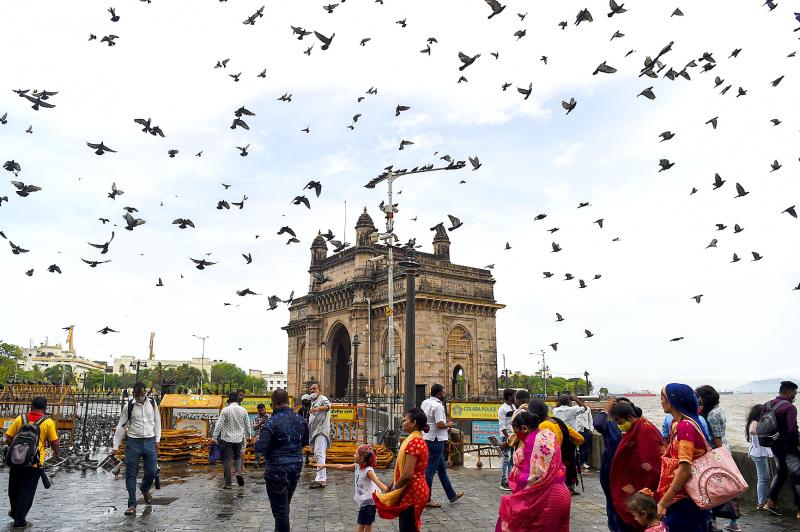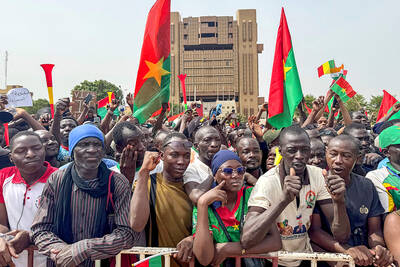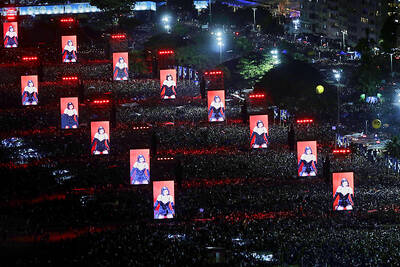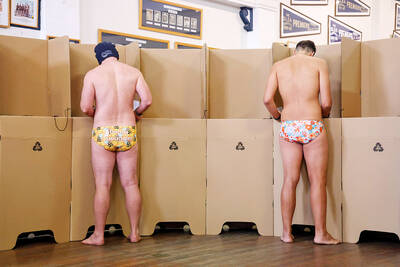When COVID-19 arrived in India, few places looked as vulnerable as Mumbai.
However, a year on, South Asia’s most crowded city has surprised many by tackling a vicious second wave of the virus with considerable success.
Gaurav Awasthi even traveled hundreds of kilometers from his home on the outskirts of Delhi to get his ailing wife a hospital bed there, paying an ambulance more than US$1,000 to drive 24 hours straight.

Photo: AFP
“I cannot ever repay my debt to this city,” the 29-year-old said, recounting an ordeal that saw him spend five days fruitlessly searching for a bed across several cities, including Delhi. “I don’t know if my wife would be alive today if it weren’t for Mumbai’s health facilities.”
The bodies began turning up early in India’s financial capital during the first wave of infections last year — a man collapsing on a busy road, a rickshaw driver slumped over the wheel — in a grim echo of the 1918 flu pandemic.
By May last year, Abhignya Patra was working 18-hour days at Lokmanya Tilak Municipal General Hospital.
“It was non-stop,” the 27-year-old anesthesiologist said.
Patients’ relatives described distressing scenes inside packed wards, with one man saying that he had to change his sick mother’s diapers himself because staff were too overworked.
A video shot inside the hospital, widely shared on social media, showed corpses wrapped in black plastic left on beds in a ward where patients were being treated.
Every night, a city hotline fielded thousands of calls from desperate residents, many with no chance of getting admitted to a public hospital: Mumbai had just 80 ambulances and 425 intensive care units for a population of 20 million.
Something had to change fast, said Iqbal Chahal, a no-nonsense bureaucrat who took over as Mumbai’s municipal commissioner in May last year.
New field hospitals added thousands of beds, private facilities handed over their COVID-19 wards to the city government and 800 vehicles were turned into ambulances.
However, these efforts could not combat the swift rise in infections.
“We needed to chase the virus,” Chahal said.
A proactive approach focused on 55 slums, including India’s largest, Dharavi, where a strict lockdown was accompanied by aggressive sanitization of public toilets, mass COVID-19 screenings and a huge volunteer effort to ensure that nobody went hungry.
All the city’s positive COVID-19 test reports were routed through “war rooms” staffed with doctors who would triage cases and decide where to send infected people, irrespective of “whether he is a minister, a big shot or a slum dweller,” Chahal said.
As last year wore on, it looked like India might have miraculously beaten the COVID-19 pandemic, and lockdown restrictions were eased.
However, Mumbai authorities did not dismantle a single bed in the now-deserted field hospitals.
This meant that when cases surged in March, the metropolis was much better prepared than many other Indian cities, where the health care system came close to collapse.
In the capital, New Delhi, and elsewhere, people died outside hospitals and crematoriums were overwhelmed — but not in Mumbai.
Despite having a much higher population density than many other cities, Mumbai has seen significantly lower mortality rates.
The city still suffered close calls, Chahal said, recalling one night in April when six hospitals faced dire oxygen shortages, putting 168 patients at serious risk unless they were shifted to other facilities — against all odds, everyone survived.
“We always expected a second wave,” Chahal said.
Patra recalled getting calls from colleagues in Delhi desperately searching for medical equipment.
“As doctors, there is very little we can do in the absence of infrastructure,” she said.
Ruben Mascarenhas, cofounder of Mumbai-based nonprofit organization Khaana Chahiye, said that he would get dozens of messages every morning from people begging for oxygen and drugs — but as the pandemic wore on, the requests mostly came from outside the city.
He was “pleasantly surprised,” but is “very cautious about celebrating yet,” Mascarenhas said.
He is not the only one.
An experienced marathon runner, Chahal is already preparing for a third wave by stockpiling oxygen and expanding capacity at public hospitals.
“This has been a wake-up call for us,” he said.

Kehinde Sanni spends his days smoothing out dents and repainting scratched bumpers in a modest autobody shop in Lagos. He has never left Nigeria, yet he speaks glowingly of Burkina Faso military leader Ibrahim Traore. “Nigeria needs someone like Ibrahim Traore of Burkina Faso. He is doing well for his country,” Sanni said. His admiration is shaped by a steady stream of viral videos, memes and social media posts — many misleading or outright false — portraying Traore as a fearless reformer who defied Western powers and reclaimed his country’s dignity. The Burkinabe strongman swept into power following a coup in September 2022

‘FRAGMENTING’: British politics have for a long time been dominated by the Labor Party and the Tories, but polls suggest that Reform now poses a significant challenge Hard-right upstarts Reform UK snatched a parliamentary seat from British Prime Minister Keir Starmer’s Labor Party yesterday in local elections that dealt a blow to the UK’s two establishment parties. Reform, led by anti-immigrant firebrand Nigel Farage, won the by-election in Runcorn and Helsby in northwest England by just six votes, as it picked up gains in other localities, including one mayoralty. The group’s strong showing continues momentum it built up at last year’s general election and appears to confirm a trend that the UK is entering an era of multi-party politics. “For the movement, for the party it’s a very, very big

ENTERTAINMENT: Rio officials have a history of organizing massive concerts on Copacabana Beach, with Madonna’s show drawing about 1.6 million fans last year Lady Gaga on Saturday night gave a free concert in front of 2 million fans who poured onto Copacabana Beach in Rio de Janeiro for the biggest show of her career. “Tonight, we’re making history... Thank you for making history with me,” Lady Gaga told a screaming crowd. The Mother Monster, as she is known, started the show at about 10:10pm local time with her 2011 song Bloody Mary. Cries of joy rose from the tightly packed fans who sang and danced shoulder-to-shoulder on the vast stretch of sand. Concert organizers said 2.1 million people attended the show. Lady Gaga

SUPPORT: The Australian prime minister promised to back Kyiv against Russia’s invasion, saying: ‘That’s my government’s position. It was yesterday. It still is’ Left-leaning Australian Prime Minister Anthony Albanese yesterday basked in his landslide election win, promising a “disciplined, orderly” government to confront cost-of-living pain and tariff turmoil. People clapped as the 62-year-old and his fiancee, Jodie Haydon, who visited his old inner Sydney haunt, Cafe Italia, surrounded by a crowd of jostling photographers and journalists. Albanese’s Labor Party is on course to win at least 83 seats in the 150-member parliament, partial results showed. Opposition leader Peter Dutton’s conservative Liberal-National coalition had just 38 seats, and other parties 12. Another 17 seats were still in doubt. “We will be a disciplined, orderly